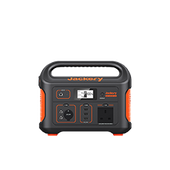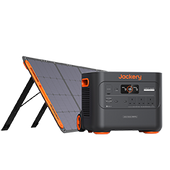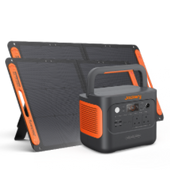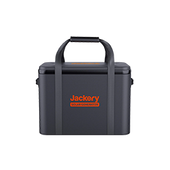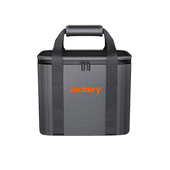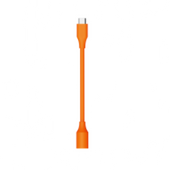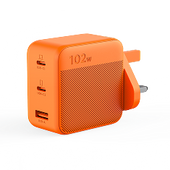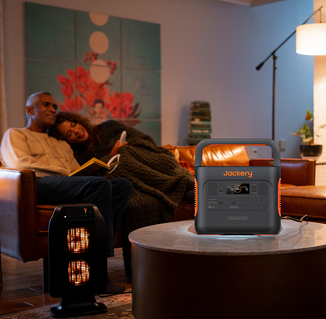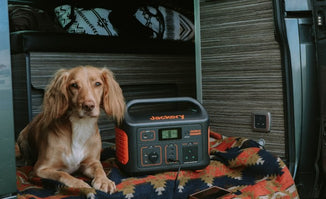You can continue working without being constrained by plugs, cords, or mains electricity when you can access batteries. While battery range might occasionally be confusing, choosing the correct battery will keep you operating productively and successfully.
This guide will show the battery sizes in the UK, examine the various battery types available, and offer advice on battery longevity, storage, and disposal. Also, when choosing the proper batteries for your home or outdoor uses, we highly recommend Jackery Portable Power Stations, which adopt high-quality lithium batteries to ensure a consistent and smooth power supply for your appliances.
|
Key Takeaways: |
|
The most common battery types - Alkaline, NiMH, and Lithium - serve different purposes. A battery's ability to hold energy generally rises with its size. Therefore, even if the 1.5V rating of both the big and small batteries is the same, the large battery has a higher capacity and a longer lifespan. The most common battery sizes are probably the ones you already use. Alkaline batteries come in 5 standard sizes: AAA, AA, C, D, and 9V. We highly recommend Jackery Explorer 500, 1000 v2, and 2000 Plus with different capacities to charge your appliances in various scenarios. |
Batteries Facts in The UK
A battery is powered by converting chemical energy into electrical energy. A chemical reaction inside the device causes one end of the battery, or cell, to become positively charged and the other negatively charged. The potential difference, the charge difference, drives electrons to move along the circuit to which the battery is attached.
How Long Does A Battery Last?
The rating and power of the device a battery is used in determine how long it will last. Milliampere-hours (mAh) are used to rate batteries. An hour's worth of continuous current can be provided by a battery rated at 2000 mAh, two hours' worth at 1000 mA, and so on. The equipment being utilised will determine the current production.
Most AA and AAA batteries have a 2000–3000 mAh capacity. This might endure for approximately ten hours for low-power gadgets like LED torches. The battery will drain considerably faster in devices with higher power consumption.
If stored properly, batteries can be kept for ten years without experiencing any degradation in performance.
Batteries Types in The UK
Three types of batteries are frequently utilised: Lithium Ion, Nickel Metal Hydride (NiMH), and Alkaline. These batteries have unique qualities due to using various metals and electrolytes, making them appropriate for multiple situations.
Alkaline Batteries: They are the most often used kind. These non-rechargeable batteries are the least expensive type and provide dependable performance throughout their lifetime due to their constant discharge. Although alkaline batteries are convenient, they are not a green choice due to their disposable nature.
NiMH Batteries: The first rechargeable batteries to be created were NiMH batteries. This skill is beneficial in terms of effectiveness and financial effect. NiMH batteries can be challenging to charge quickly, and their power output decreases with repeated recharges.
Lithium Batteries: A more recent advancement in rechargeable batteries, lithium-ion batteries, is now frequently used in phones and computers. Although initially more expensive than NiMH, they will save money because of the feasible recharges. Lithium batteries are more popular because of their faster charging times and more constant power production throughout their lifetime.
According to the image, it is clear that lithium batteries are better than others, regardless of battery capacity, resistance, energy density, or self-discharge rate. Jackery Portable Power Stations use lithium batteries (lithium-ion and LiFePO4 batteries) to ensure a stable and consistent power supply with higher capacities.
Different Battery Sizes in The UK
Different battery sizes affect your equipment's overall efficiency, but it's essential to understand why. A battery's ability to hold energy generally rises with its size. Therefore, even if the 1.5V rating of both the big and small batteries is the same, the large battery has a higher capacity and a longer lifespan.
The most common battery sizes in the UK are probably the ones you already use. Alkaline batteries come in 5 standard sizes: AAA, AA, C, D, and 9V. Batteries are commonly found in various household devices, including TV remotes, clocks, and digital cameras. Alkaline batteries account for 80% of battery sales in the UK. Standard alkaline batteries can sometimes be confused due to the different numbering systems used.
Size AA is referred to as LR6, MN1500, or MX1500. Size AAA corresponds to LR03, MN2400, or MX2400. Size C batteries may also be marked as LR14, MN1400, or MX1400. D batteries are labelled as LR20, MN1300, or MX1300. 9V batteries are referred to as 6LR61, PP3, MN1604, or MX1604. Understanding the various labels helps you locate the batteries you require!
AA Batteries are the most popular, sometimes called "double A" batteries. These batteries are readily accessible and have a wide range of uses.
Most people think of regular replaceable batteries and usually imagine double-A batteries. These batteries are widely used in various devices, including cordless phones, staffed pagers, and thermometers.
AA batteries, which have a 1.5V measurement, are suitable for gadgets that need a moderately high current consumption but are not used continuously. They can also be utilised for low-energy, always-on devices like clocks.
AAA Batteries: AAA batteries are the second most common type, sometimes called "triple A" batteries. They are utilised for thermometers, calculators, and little toys. Small electrical appliances like kitchen timers, graphing calculators, TV remote controls, and bathroom scales frequently use AAA batteries.
AAA batteries have a 1.5V measurement but provide less energy because of their smaller size. Kitchen timers and other tiny appliances with low energy requirements are the main uses for these batteries. The batteries will still serve their duty for a very long period. These little batteries also power thermometers and portion control scales.
AAAA Batteries: Although less common than their AA and AAA counterparts, "quadruple A," or AAAA, batteries are potent. LED penlights and laser pointers frequently use these compact yet potent batteries. Additionally, they are found in tiny gadgets like computer styluses with power, hearing aid remote controls, and diabetes meters.
C Batteries: Toys, flashlights, and portable radios are the primary uses for these heavy-duty batteries. These 1.5V batteries are needed for a lot of automatic hand sanitiser dispensers. Ideal for demanding applications requiring regular battery changes, you can be sure your gadget runs on dependable, secure power. These batteries are also commonly used in restrooms, including flush sensors that run on batteries.
D Batteries: These batteries are best suited for stereos, large flashlights, and hands-free soap or paper towel dispensers - devices that need prolonged power.
D batteries are necessary to power the majority of automatic paper towel dispensers. Numerous commercial heavy-use gadgets, such as hands-free sensor faucets, air freshener systems, and soap dispensers, can be powered for hours by these big batteries.
9V Batteries: The 9-Volt battery, recognisable by its rectangular form, is utilised in gadgets that require high voltage and substantial power. Electronic portion scales, battery-operated temperature alarms, and infrared thermometers are just a few examples of gadgets that benefit significantly from 9V batteries.
These products could come into contact with scorching food, walk-in coolers, or other kitchen appliances. 9V batteries function well in temperatures ranging from 0 to 130 degrees Fahrenheit and are incredibly resilient.
CR123A Batteries: They are widely used for home automation, wireless security, and tactical equipment because of their high capacity.
The CR123A battery has twice the voltage of an AA battery but is much shorter than an AA battery. It produces 3 volts. These batteries are pretty small in size, yet they provide a tremendous amount of power. They guarantee optimal performance, making them perfect for high-power gadgets like LED torches. Because of its high power-to-size ratio, this battery will survive longer than others.
Lithium Batteries: There are, of course, a lot more kinds of batteries than just alkaline ones. Lithium coin cells are being used in more and more things, like car keys, 3D glasses, watches, and cooking scales. This battery is also used in exercise watches that look like Fitbits.
About 7% of all batteries sold in the UK are lithium coin cell batteries. It's easier to keep track of lithium coin cells' numbers. Most of them begin with CR and then four numbers. A CR2032 cell, for instance, is 20 mm across and 3.2 mm thick. If you don't know what kind of coin cell you need, this can help.
How Battery Size Affect Battery Performance & Capacity?
A battery's performance and energy storage capacity can be significantly impacted by its size. Even though the measurements may differ based on the particular kind of battery (lead-acid, lithium-ion, alkaline, etc.), the following are important considerations:
Energy Storage Capacity
The size and storage capacity of batteries are often closely connected. A larger battery can retain more energy than a smaller battery of the same type. Watt-hours (Wh) and ampere-hours (Ah) are standard battery ratings. A bigger battery will usually hold more energy.
Performance
The battery's performance may also be impacted by its size. Larger batteries can provide current faster due to their increased capacity. This is crucial for high-power consumption applications like high-end electrical products or electric cars.
Furthermore, a larger battery could last longer and go through more charge-discharge cycles before losing performance.
Physical Size & Portability
It's crucial to understand that a battery's energy density - or the quantity of energy held relative to its weight or volume - has nothing to do with its size. Certain battery technologies, like lithium-ion batteries, can provide high capacity in a small package and have a high energy density. This is particularly important for portable electronics like laptops and cell phones, where balancing battery size and storage capacity is essential.
When choosing a battery for a particular use, it is crucial to consider the power requirements and strike the right balance between its physical dimensions, capacity, and intended performance.
How to Determine The Battery Size?
Selecting the proper battery sizes guarantees that your power system effectively meets your energy needs. An increasing number of British houses and companies are converting to solar energy solutions with lithium-ion batteries for improved self-consumption and power backup due to the increased popularity of rooftop solar and rising electricity rates.
When choosing a battery, you must weigh various considerations, including backup time, number of charging cycles, space restrictions, upfront expenses, safety, etc. This blog explains how to calculate the best lithium-ion battery capacity for your application using an easy, step-by-step process.
Step 1: Estimate Your Load Requirements
The first step is finding out how much energy you use daily. List all the electronics and appliances you want to be powered by solar energy. Please note their wattages and daily expected runtime. This will provide you with the average daily load (measured in Watt-hours) that your battery-operated solar energy system must be able to support.
For instance, a 60-watt fan operating for six hours a day will use 60*6 = 360 Wh of energy. For trouble-free operation, size your solar system to accommodate 120-150% of your average daily load, considering potential load growth and seasonal variations.
Step 2: Determine Backup Time Needed
The crucial backup time you require during power outages determines the battery capacity. When grid supply is disrupted, most homeowners and small and medium-sized enterprises (SMEs) aim for a 3-5 hour solid backup to run lights, fans, mobile charging, etc.
Nonetheless, larger battery banks are built to give a more extended backup of at least 10-15 hours for applications like telecom towers and off-grid houses. Determine your load requirements during a power outage and choose the ideal backup time appropriately.
Step 3: Calculate Total Battery Capacity
Watt-hours (Wh) are used to express battery capacity. Once your intended backup time and average daily load are known, you can use the following calculation to determine the total amount of lithium-ion battery capacity required:
Average Load (W) x Backup Time Needed (hrs) = Battery Capacity (Wh).
To supply a 1 kW load for 4 hours during a grid outage, for instance, the lithium-ion battery capacity needs to be at least 1 kW x 4 hours = 4,000 Wh, or 4 kWh.
As a general guideline, consider that only 70-80% of the reported battery capacity is useable to account for optimal battery usage and prevent over-discharging.
Step 4: Select Suitable Battery Voltage
For the system to work correctly, the battery bank voltage (rated at 48V, 51.2V, etc.) must match the requirements of the charge controller and inverter. Higher voltage battery banks increase system efficiency and minimise the need for larger cables, but they may also call for extra safety precautions. The highest value for residential settings can be found in 48V lithium-ion battery banks.
Step 5: Determine Your Batteries Sizes
The market's available battery capacity ratings range from 50 to 10,000 Ah. To determine the battery sizes that need to be wired in series or parallel, divide your total calculated battery capacity by the capacity of the battery model that you have chosen.
Using 150 Ah 48V lithium batteries, the battery back calculation for the 1kW x 4hr = 4 kWh calculation above would require 4000 Wh ÷ (150 Ah x 48V) = 5.5 = 6 batteries. Incorporate a reserve of 20-30% for potential future capacity growth.
Optimal Solar Battery Selection by Application
In addition to battery size, choosing the right lithium-ion battery chemistry and characteristics for your operating environment is crucial for optimal solar performance. Let's examine a few essential selection criteria for diverse applications:
Residential Homes: Prioritise safety, affordability, and lifespan when selecting a home solar battery. The LFP (lithium iron phosphate) chemistry offers the highest chemical and thermal stability. Select reputable companies that provide integrated battery management systems (BMS) for cell safety and monitoring. Take a hard look at the warranty's coverage and assurances.
Consider intelligent hybrid inverters that facilitate smooth transitions between grid power, solar energy, and batteries to reduce disturbance. This allows peak power consumption to be reduced by using time of day. With fewer space constraints, pooled community battery banks offer superior economics for multi-level apartments and housing societies considering solar electricity.
Commercial Buildings: Businesses such as hospitals, malls, and offices need to continue operating during blackouts. Examine the containerised plug-and-play lead-acid and lithium-ion battery systems that offer scalability and simplicity of installation.
Jackery Portable Power Stations with Lithium Batteries
Except for rechargeable batteries for daily appliances, there are batteries adopted for generators or solar products. Lithium batteries are commonly used for power stations because of their higher capacities, higher power densities, and more advantages. Jackery Portable Power Stations have lithium-ion and LiFePO4 batteries to ensure sufficient power supply in the UK for indoor and outdoor uses.
Jackery Portable Power Stations range from 99Wh to 12 kWh, enabling enough electricity for camping, off-grid living, power outages, or emergencies. It can recharge in multiple ways, including Jackery Solar Panels, wall outlets, and carports.
Jackery Explorer 500
Jackery Explorer 500 is smaller than Explorer 2000 Plus or 1000 v2, but it is best for people enjoying outdoor activities like hiking, boating, fishing, camping, etc. It is a 518Wh lithium portable power station and one of the market's lightest rechargeable lithium battery generators.
- Portable Power Solution for Electronics: The Jackery Explorer 500 is one of the lightest and most portable rechargeable lithium battery generators available today. It includes a PURE SINE WAVE 500-wattAC outlet that delivers stable power to various AC-dependent devices, such as portable fans, projectors, coolers, and lights.
- Versatile Charging Outputs: This versatile portable power station has three USB ports, a 12V car output, and an AC outlet, ensuring reliable power for your appliances. The power station can be charged through three distinct methods: solar panels, a car outlet, and an AC adapter.
- Safe & Strong for Multiple Uses: The Explorer 500 features an emissions-free energy source and a dependable battery management system, ensuring its safety for indoor use. Constructed from robust material, the solar system exhibits resistance to high temperatures.
|
*Review from Our User |
|
The Jackery Explorer 500 serves as a comprehensive solution for campervan electrical systems. This product features a lithium battery, a pure sine wave inverter, and an MPPT charge controller, all in one portable unit weighing just 6kg, which makes it ideal for van life enthusiasts. |
Jackery Explorer 1000 v2
The Explorer 1000 v2 Portable Power Station has an impressive 1500W output, 50% greater than earlier models, efficiently supplying power to high-demand appliances in an emergency, such as refrigerators, computers, CPAP machines, and more.
- Charge Appliances Simultaneously: Equipped with USB-A/C connections and dual PD charging up to 100W, it can simultaneously charge numerous devices, rendering it the ideal companion for all your power requirements.
- Emergency Charge Mode: The Emergency Charge Mode, activated via the app, enables the Explorer 1000 v2 Portable Power Station to achieve a full charge in under one hour, providing essential power backup when the battery is depleted. Moreover, charging from 0% to 100% within two hours via an AC wall outlet prolongs battery longevity.
- Whisper-Quiet Operation: Experience serenity with its nearly silent operation, maintaining noise levels below 22dB while energising your devices. This power station guarantees an uninterrupted power supply for a caravan, camper, off-grid tiny house, or home.
|
*Review from Our User |
|
I bought this Explorer 1000 v2 as a backup power supply. I was primarily worried about ensuring that our refrigerator would stay operational during a prolonged outage. We performed a load test today. Our (smallish) fridge used approximately 100W while operating when fully charged. After 7.5 hours, we still had a 40% charge left. This will ensure everything operates smoothly throughout the night. |
Jackery Explorer 2000 Plus
Jackery has introduced the Explorer 2000 Plus, a state-of-the-art portable power solution that delivers outstanding performance. With its impressive capacity and powerful output, this device can support the operation of typical household appliances for weeks, which is best for emergencies or power outages.
- Expandable Powerhouse for Your Appliances: The Jackery Solar Generator 2000 Plus enables the addition of extra battery packs, increasing the capacity from 2 kWhto an impressive 12 kWh, thereby significantly improving the solar charging capabilities. This solar product has a remarkable output of 3000W, providing a 30% higher rated power than other 2 kWh solar products. Almost all necessary household appliances are powered.
- Higher Resistance & Reliability: The Explorer 2000 Plusstands out as a groundbreaking add-on battery pack that offers the convenience of recharging through solar panels. This feature increases versatility, boosts charging efficiency, and shortens charging time.
- Lower Noise for Safe Use at Home: The whisper-loud noise and quiet-charging mode make the Jackery Explorer 2000 Plus an ideal companion for home use. Reduced noise fosters a tranquil and pleasant atmosphere, alleviating stress and enhancing overall well-being.
|
*Review from Our User |
|
Excellent battery backup for thunderstorms and other power outages. We have only two solar panels, so the charging process is slow. It functions well, and we are considering adding more panels. Our refrigerator has been running smoothly without any issues. I also set up a small AC and laptop computer to check if I could power my office. |
Batteries Sizes in The UK FAQs
The following are the frequently asked questions about the batteries sizes in the UK:
- Are batteries different in the UK?
Even though the batteries go by different names, regular consumer batteries are the same everywhere worldwide. For instance, AA batteries are sometimes called LR6, although they should be readily available and interchangeable everywhere. Indeed, in the same way.
- Are batteries the same in the UK and the US?
Indeed, standard consumer batteries are universally consistent, albeit their nomenclature differs globally. AA batteries are designated LR6 in many countries, yet they are universally available and function identically.
- What is the British standard for batteries?
The British Standard (BS) is a generic term for high-integrity batteries that satisfy rigorous safety, performance, and durability standards. The industry did not establish specific safety standards for several years after the introduction of Valve Regulated Lead-Acid (VRLA) batteries in the early 1980s.
- What size are battery terminals in the UK?
The typical UK types are readily identifiable due to their prevalence. The measurements at the base of the tapered terminal are 17.5mm for the negative post and 19.5mm for the positive terminal.
Final Thoughts
It's essential to understand the various battery sizes available in the UK when selecting the right power source for your devices. With performance, capacity, and environmental impact all considered, you can make well-informed decisions that increase sustainability and efficiency in your energy consumption.









